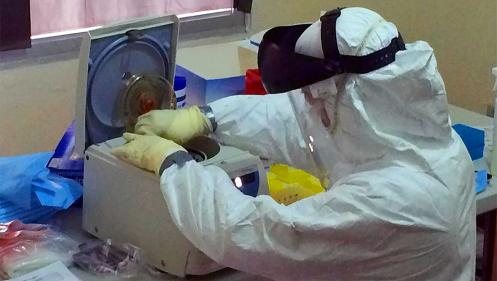U.S. Department of Defense and FDA collaborate to help speed potential countermeasures for Ebola and other viruses

Background | Project description | Project outcomes | Related links
Performer: U.S. Army Medical Research Institute of Infectious Diseases (USAMRIID)
Project leader: Karen Martins, PhD
Contract value: $202,114
Project dates: September 2018 to September 2021
Background
Understanding microbial pathogenesis—the mechanism by which microbes cause disease—is essential for developing medical products to prevent, diagnose, and treat microbial infections. This requires not only an understanding of the pathogenic microbes, but also the cellular and immune responses those microbes stimulate in infected people.
However, obtaining samples from people who have been infected to study their cellular and immune responses can be difficult, particularly for rare viruses such as Ebola, Marburg, Rift Valley fever, and Crimean Congo hemorrhagic fever due to logistical, regulatory, and ethical considerations.
Project Description
FDA awarded a three-year interagency agreement to USAMRIID to establish a better understanding of the microbial pathogenesis of several viruses: Ebola, Marburg, Rift Valley fever, Crimean Congo hemorrhagic fever, Chikungunya virus, and Zika.1
This project will leverage the U.S. Army’s Joint Mobile Emerging Disease Intervention Clinical Capability (JMEDICC) project, a collaboration between U.S. and Ugandan researchers to establish a capability to conduct clinical trials while treating patients during a filovirus outbreak (such as Ebola or Marburg).
As part of establishing JMEDICC, researchers are conducting an observational sepsis study to better understand microbial pathogenesis as it relates to sepsis while building a base of severe infectious disease clinical research operations and training. Blood samples obtained as part of the sepsis study will be assessed for evidence of previous infection with the target viruses of this projects, and those that are positive will be used to study pathogenesis–in particular, immune response.
Project Outcomes
Through this collaboration, the USAMRIID team will:
- Identify patients with previous exposure to the target viruses, and collect serological samples at several time points from the patient’s initial presentation to the hospital, up to 28 days later;
- Assess immune response by re-stimulating peripheral blood mononuclear cells (PBMCs), where available, to measure frequency and breadth of cell-mediated immunity to the infecting antigen (in this cases, virus), and by assessing antibody avidity (the overall strength of binding between the antibody and antigen) and neutralizing capability, including kinetic analysis over time.
- Compare immune responses in patient samples with immune responses from other sample sets (e.g., vaccine studies, etc.) to determine appropriate samples to use in bridging data from natural exposure samples to human vaccine cohorts, animal models, or geographically distinct patient populations
In addition, this funding will help identify and enable access to hard-to-obtain samples to additional FDA research partners, including other institutions in support of MCM regulatory science research.
This work will help advance the understanding of the microbial pathogenesis of viral hemorrhagic fevers and Zika virus in humans—a key step toward enabling the development of MCMs.
This project was funded through the MCMi Regulatory Science Extramural Research program.
1 In addition to the possibility of natural outbreaks, viral hemorrhagic fevers including Ebola and Marburg are defined as Category A high-priority bioterrorism threat agents.
Related Links
- Makerere University Walter Reed Project: JMEDICC
--])
- FDA/DoD collaborations, for a joint program to prioritize the efficient development of safe and effective medical products intended for deployed American military personnel
